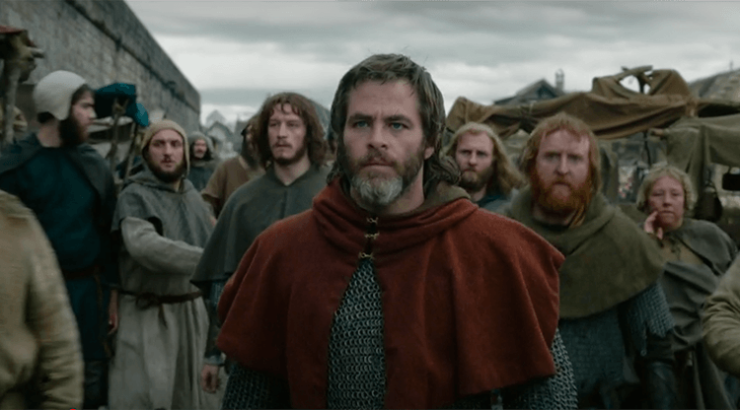So I more or less eviscerated Braveheart in my last column, and along the way more than one person asked about how Mel Gibson’s history hack compares to a new film dealing with the same period: Netflix’s Outlaw King (Dir. David Mackenzie), starring Chris Pine as Robert the Bruce—as the movie and popular tradition call him—the guy whose nickname really was Braveheart.
Well, let’s press Play on today’s column and find out!
OK. We start off with a pretty standard opening of Ye Olde Historical Note, intended to situate an unfamiliar audience with where we are at.
It’s 1304. William Wallace is on the run. The Scots are split between supporters of two families—that of John Comyn and that of Robert Bruce—but they’re unified in that their general rebellion against the English has failed. As we start the movie, King Edward I of England is laying siege to the last holdout to his authority, Stirling Castle, while he is accepting oaths of submission from Bruce, Comyn, and the rest of the Scots nobles.
Reader, you may recall that I spent almost an entire column crapping all over the opening hysterical historical note in Braveheart, so I’m super excited to say that there aren’t any enormous whoppers here. Honestly, my biggest complaint so far is that the font size for Ye Olde Historical Note is much too wee.
This movie is not, in other words, Braveheart’s complete dipshittery.
More than that, it’s looking, dare I say, pretty damn good. The film opens with Edward I (Stephen Dillane) accepting homage from Robert (Chris Pine), who is kneeling before the king.
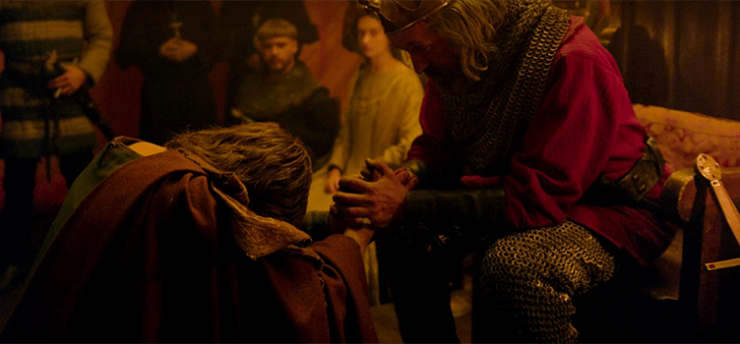
No, no. Let me be clear. He’s not just kneeling like any mere schmuck can do. He’s kneeling like a man pledging homage. And not Hollywood homage. Not whatever a mullet-bound Gibson would have done with this. I say again, he’s kneeling like a man pledging homage. The camera pans across the way Robert’s hands are clasped inside Edward’s hands, and they’re just like they ought to be and I’m so very happy.
And … whoa … what’s this? There’s not a kilt in sight. Not. One. Kilt.
Oh gods, this can’t be happening. Are they dressed in … wool? Like regular wool outfits? Belted, with a folded-back knot that drapes the tag-end down just so? Jeepers, even the haircuts are pretty solid overall.
And we’re inside a pavilion? The king’s campaign pavilion? Oh hell yes.
And did I mention that they shot this opening in what appears to be one really long shot? I friggin’ love long, choreographed shots like this.
People, I’m two minutes into this movie and I feel like I maybe want to have its babies.
Yeah, I know this is probably a rebound. I just got out of that terrible night I spent with Mel Gibson. I’m in a dark place, and my bar is low … but even setting all that aside, this seems pretty good so far. I’m starting to feel like we might have something here, me and this movie.
I mean, sure, I could grumble about how the movie insists on an utterly drab colo(u)r palette for the garb of the Scots, but it’s just little things so far. Nothing to make me worry about this relationship we’re building, right?
Exiting the pavilion, we see the English camp, and it’s quite rightly all mud. We also get a great chat between Robert and the Prince of Wales (Billy Howle)—the future Edward II—that nicely sets out their characters. It’s clearly positioning Eddie the Younger as Robert’s main antagonist for the arc of the film. I’m thinking this will necessitate some timeline tinkering down the line, but we’ll see.
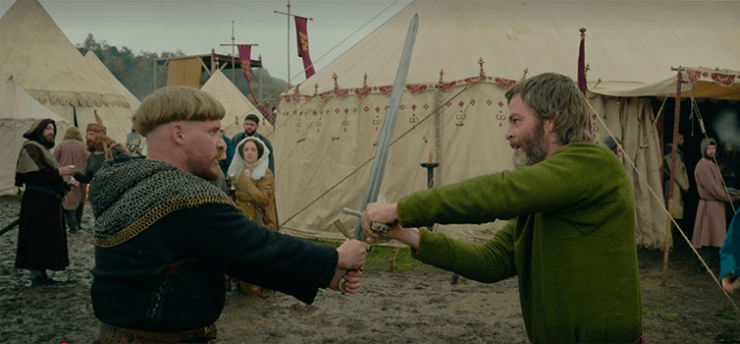
You know, I’ve got to pause it here to note how much I’m pleased with the way they’re portraying the Prince of Wales. Here again, let me make a comparison to Braveheart. In that dumpster dive of a historical film, the filmmakers portrayed the future Edward II as a homosexual.
Now, on a historical basis, it’s true that there was a lot of talk about Edward II’s sexuality even in the Middle Ages—most of it focusing on his very close relationship with Piers Gaveston—and whatever truth there was behind those rumors, his relationship with Gaveston definitely had some historical repercussions. As such, his sexuality can be a potentially interesting topic to explore, especially in light of the ways in which it forces us to confront the variation not just of human sexuality at a root level, but also in the way that cultures can respond to that variation. And Edward II might be additionally fascinating in this regard since any discussion of his sexuality in binary terms must surely raise an eyebrow given the fact that he fathered multiple children. And lest we think this was just a matter of doing the necessities of the state, we know of at least one illegitimate son who resulted from an affair. So was he bisexual? Heterosexual with a very passionate and largely misunderstood friendship? Some other fascinating glimpse into …
Oh nothing even remotely like this is in Braveheart, my dear reader. In that half-heated plate of lunatic leftovers, the future Edward II is won’t-touch-his-wife homosexual. And for the filmmakers that means—because of bigoted stupidity—he’s whimpering and rather effeminate.
So, yeah, watching how Outlaw King presents his sexuality is like a breath of fresh air. Because you know how it presents it?
It doesn’t.
Because it’s not pertinent to the story. Whether he’s bisexual, heterosexual with a super duper extra plus-plus best friend, or some other identification, it just doesn’t matter. About the only hint you can get of it is when the prince asks “Piers,” who is off-screen, to fetch a sword for Robert in their opening duel of gentlemen.
Like I said, I sorta want to have this movie’s babies … which is surely another sexual category entirely.
Moving on in the film, we get to see Edward presenting an absolutely massive trebuchet. You’d be right to wonder about the accuracy of having such a ridiculously large machine built on campaign in Scotland—it looks like Hollywood hyperbole, I know—but this is based on a real thing. We quite literally have the receipts for its making. It was called the War-wolf, and it was one big and badass war machine. So, yeah, I squealed a bit when I realized what they were portraying … only to groan when they then fired it.
Why? Well, because they fired it.
No, they didn’t say “Fire!”—you know how much that verb pisses me off when associated with non-gunpowder weaponry—but they did something almost as bad: they set it on fire.
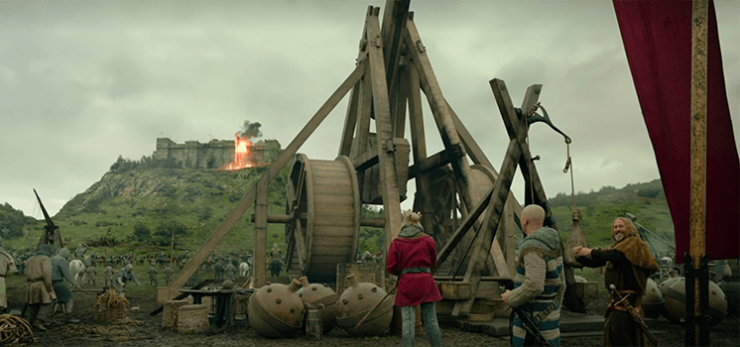
To be precise: Outlaw King has England’s King Edward I—having constructed at Stirling Castle the largest trebuchet that anyone there had surely ever seen (it took over 30 wagons to carry the parts of the damn thing)—deciding, for the War-wolf’s first usage, to light its projectile stone ablaze by slathering it in “Greek Fire.”
The War-wolf, I will point out, is made of flammable wood and rope.
Also, such incendiaries—and some were used at Stirling, though whether you’d risk the War-wolf with them is questionable—were almost assuredly done with what we might call fused pots.
Anyway, this being a movie, of course, nothing goes wrong. But, still, what the hell? What happened, movie? Things were going so well. I had plans to introduce you to my parents!
Speaking of parents, Robert’s dad looks really super good for a man who had been dead for a few months at this point.
Of course, timeline tweaking is often to be expected in these sorts of movies. The world doesn’t tend to follow the beats and arcs of movie productions. The most that one can hope is that the tweaking isn’t too egregious. And by such a measure, Outlaw King is mostly a success. Yes, Robert’s dad should have been pushing up the daisies before the movie starts. Yes, our hero actually married Elizabeth de Burgh two years before the movie has him doing so. (Though Florence Pugh was delightful and stole every scene she was in.)
In short, a lot of timeline bits are tweaked in order to accommodate the structure of the film. Importantly, though, I don’t see real harm in these tweaks. It’s quite different, to my mind, than, say, having William Wallace bed Isabella of France in order to sire the future Edward III because the gay Edward II, on account of his feminizing gayness, clearly isn’t man enough to do it his gay self—::cough:: Braveheart ::cough:: ::barf::—when in reality Isabella was a child and the whole scenario feels both pedophilic and ragingly homophobic.
In sum, much of the Outlaw King is a mix of apparent truth with less apparent wrong.
Robert’s wedding to Elizabeth has proper liturgy, for instance, but no church then in Scotland was as grand as that pictured in the film.
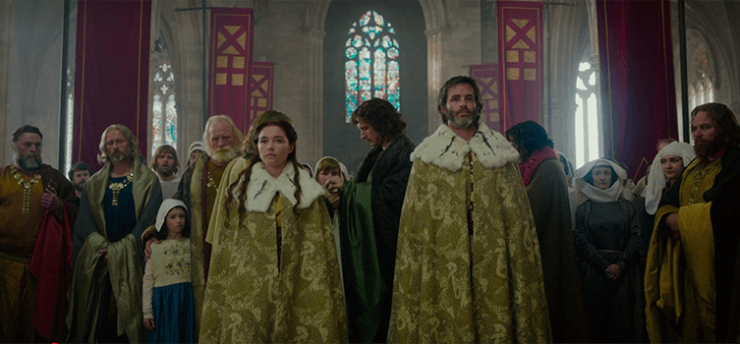
The movie shows one of the quarters of William Wallace being displayed at Berwick, which is true enough as an event in 1305 (fun fact! the three other quarters of his body were at Newcastle, Stirling, and Perth), though it was hardly the catalyst to the renewal of rebellion as the film portrays.
Wallace’s head was set on a pike on London Bridge, and the film gets that right, too, though the Outlaw King shows it as bare-skinned when it ought to be covered in preservative tar.
Buy the Book
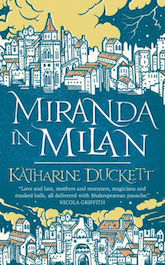

Miranda in Milan
Oh, and the scene showing Wallace’s head on London Bridge—along with every other scene in the movie in which Englishmen use it to rush in or out of town—implies that Scotland is south of London. This is—::triple-checks notes::—incorrect.
The armor is really good in scene after scene, but then they’ve got the Prince of Wales wearing something unrecognizable.
Folks were indeed set outside castle walls in cages—Robert’s sisters apparently got that treatment—but Elizabeth would not have been. Her father was too powerful an ally to the English crown to treat her so badly. The filmmakers, alas, are falling into Braveheart’s lazy notion of demonizing the English in order to make the audience sympathize with the Scots.
Still, there are a lot of great little historical Easter eggs.
When Robert is eventually crowned at Scone, for example, they note how the English had stolen their stone. They sure had! It’s called the Stone of Scone, and by legend Scottish kings for centuries had been crowned upon it … until Edward I took it in 1296 and had it built into the English coronation throne so that kings of England would literally have their asses above Scotland. It was only returned to Scotland in 1996, which means that by any documented measure more English than Scottish monarchs have been crowned upon it.
And take the Battle of Methven. The movie actually worked into the script something like Elizabeth de Burgh’s reported declaration that she and her husband were “but a summer king and queen whom children crown in their sport.” I mean, okay, they probably wouldn’t be camped in the woods quite like that when she said it … and I wish they’d have made it clear that Methven was mostly a disaster on account of the Scots foolishly neglecting to set a watch, and why the bleeding heck must the ambushing English be depicted as lighting all their arrows before shooting them into the air in the ambush? And why is …
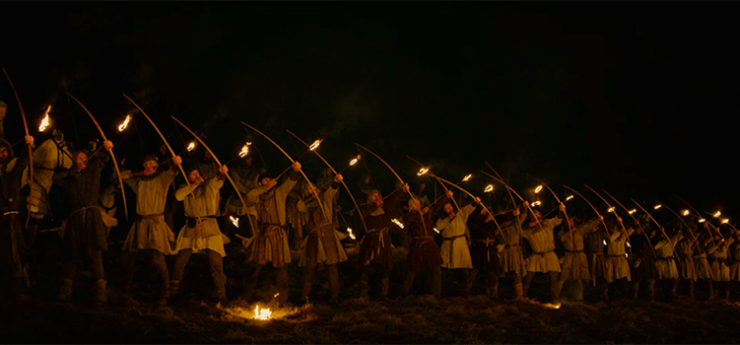
Oh shut up, Mike. Yes, there are a lot of mistakes, but damn if this isn’t generally correct-ish on a scale that Braveheart can’t imagine.
…
OK, damnit, I know I said I’d let the slip-ups go, but I have to get this last one off my chest.
At the end, in the big final showdown of the Battle of Lowdoun Hill—why in the nine levels of Dante’s Hell didn’t they use Bannockburn as the climax?—when Robert and You-know-who fight…
Well, You-know-who wasn’t at that battle. And even if he was there, and he was beaten the way the movie has it, he would not have been allowed to slink off the field. Are you shitting me? For pity’s sake, if any of the Scots on the field could have captured You-know-who-oh-toss-it-you-know-it’s-Edward II they sure as bloody hell would have done so and either slit the bastard’s throat and plunged England into political crisis or imprisoned him and then ransomed him back to England for Robert’s family and such an utterly exorbitant price that Scotland’s independence might well have been assured for generations.
Let him slink away instead? Oh hell no, movie. Whatever we had between us, it’s over.
And it’s not me. It’s you.
PS: I will, though, really cherish the memory of what you did with the Black Douglas (Aaron Taylor-Johnson). “What’s my fooooking name?!?” Hahaha.
PPS: And for what it’s worth, despite some pacing problems, moments of historical stupidity, unnecessarily egregious viscera, and really odd choices in structure, you’re now on the short list of movies I can recommend for people to get a decently historically accurate look at this little slice of time. Well done indeed!
Mike’s Medieval Ratings
Accuracy: 6 out of 10 thistles on my pillow
Just Plain Fun: 9 out of 10 Douglas Larders
 Michael Livingston is a Professor of Medieval Culture at The Citadel who has written extensively both on medieval history and on modern medievalism. His historical fantasy trilogy set in Ancient Rome, The Shards of Heaven, The Gates of Hell, and The Realms of God, is available from Tor Books.
Michael Livingston is a Professor of Medieval Culture at The Citadel who has written extensively both on medieval history and on modern medievalism. His historical fantasy trilogy set in Ancient Rome, The Shards of Heaven, The Gates of Hell, and The Realms of God, is available from Tor Books.










